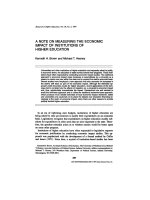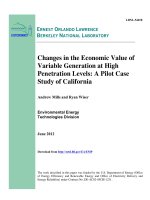WHAT''''S IT WORTH? THE ECONOMIC VALIE OF COLLEGE MAJORS potx
Bạn đang xem bản rút gọn của tài liệu. Xem và tải ngay bản đầy đủ của tài liệu tại đây (11.09 MB, 182 trang )
Anthony P. Carnevale
Jeff Strohl
Michelle Melton
3
• Introduction
3
• Acknowledgements
Acknowledgements
We would like to express our gratitude to the individuals and organizations that
have made this report possible. First, we thank the Lumina Foundation and the
Bill and Melinda Gates Foundation for their support of our research over the past
few years, and in particular, we are grateful for the support of Jamie Merisotis,
Hilary Pennington, Holly Zanville, and Parminder Jassal. We are honored to be
partners in their mission of promoting postsecondary access and completion
for all Americans.
We also want to thank our editor, Vic Caleca, and our designer, Woodpile Studios,
as well as Ban Cheah, Nicole Smith, Stephen Rose, Tamara Jayasundera,
Laura Meyer, Peter Daniels, and numerous other colleagues, too many to list here,
who provided support and insight throughout the process.
63773_Text.indd 3 4/26/11 8:07 AM
5
• Table of Contents
Table of Contents
Introduction 6
Summary of Findings 8
Table of Major Groups 30
Comparison Across Major Groups 32
Agriculture and Natural Resources 46
Arts 54
Biology and Life Science 62
Business 74
Communications and Journalism 82
Computers and Mathematics 90
Education 98
Engineering 110
Health 124
Humanities and Liberal Arts 132
Industrial Arts and Consumer Services 144
Law and Public Policy 152
Physical Sciences 160
Psychology and Social Work 168
Social Science 176
63773_Text.indd 5 4/26/11 8:07 AM
6
• Introduction
Answering that big general question has been
relatively easy, then. But other, more specific
questions have been harder to resolve. Namely,
which majors should students consider if
they want the best chance of earning family-
sustaining wages? And, are all Bachelor’s
degrees the same?
Over the years, there has been a persistent
lack of available information about the
economic consequences of choosing one
academic major over another. As a result,
students have had little financial data on
hand to help them choose between majors.
No longer. Our report finds that different
majors have different economic value. While
going to college is undoubtedly a wise deci-
sion, what you take while you’re there matters
a lot, too. On average, as we stated, Bachelor’s
degree holders earn 84 percent more than
those with a high school diploma. However,
returns to majors run a wide gamut. At the
extreme, the highest earning major earns 314
percent more at the median than the lowest-
earning major at the median.
Although earning potential is not the only
issue a student should consider when
selecting a major, we believe it is an important
one. That is why we detail the economic value
of 171 specific undergraduate majors.
1
Introduction
When considering the question
of whether earning a college
degree is worth the investment
in these uncertain economic
times, here is a number to
keep in mind:
84 percent.
On average, that is how much more money
a full-time, full-year worker with a Bachelor’s
degree can expect to earn over a lifetime than
a colleague who has no better than a high
school diploma.
Clearly, for most students, when asked
whether to go to college, the answer should
be a resounding “yes.” And statistics show
that Americans are drawing that conclusion in
ever-growing numbers. Since 1992, the propor-
tion of workers with Bachelor’s degrees in
the U.S. labor force has grown from 28 percent
to 34 percent.
At the extreme,
the highest
earning major
earns 314 percent
more at the
median than the
lowest-earning
major at the
median.
63773_Text.indd 6 4/26/11 8:07 AM
7
• Introduction
To summarize, while we found that any degree
is better than no degree, we also found that
there are significant differences. For example,
the median earnings for full-time, full-year
workers with Bachelor’s degrees (but no
graduate diplomas) vary dramatically — from
$29,000 for Counseling Psychology majors to
$120,000 for Petroleum Engineering majors.
In some ways, then, a student’s choice of
undergraduate college major can be almost
as important as deciding whether to get a
Bachelor’s degree at all.
Among other things, we detail:
l
Median earnings and earnings variation
among typical workers (at the 25th and 75th
percentiles) for all (not only recent graduates)
full-time, full-year workers with a terminal
Bachelor’s degree.
l
These same earnings information by gender
and race/ethnicity.
l
The likelihood that a person with a specific
major will obtain a graduate degree and the
subsequent earnings return that a graduate
degree confers.
l
The pathways between education and work:
which occupations and industries employ
the most workers with various majors.
l
Data on labor market attachment (employ-
ment and work status) by specific
undergraduate major.
In the summary of findings, we give an
overview that compares all detailed majors
by earnings, gender and racial/ethnic composi-
tion, labor force characteristics, and the like.
The second section aggregates the 171 majors
into 15 major groups. These groups are:
l
Agriculture and Natural Resources
l
Arts
l
Biology and Life Science
l
Business
l
Communications and Journalism
l
Computers and Mathematics
l
Education
l
Engineering
l
Health
l
Humanities and Liberal Arts
l
Industrial Arts and Consumer Services
l
Law and Public Policy
l
Physical Sciences
l
Psychology and Social Work
l
Social Science
The second section compares earnings and
other outcomes across broad major groups.
For example, we detail the wages for Physical
Sciences majors compared to Humanities and
Liberal Arts, and the likelihood of attaining a
graduate degree between Education and Com-
munications and Journalism majors.
The remaining sections deal in detail with
each of the 15 major groups. They compare
the majors within these groups, providing
information on, for instance, the differences
in earnings between a General Business major
and an Accounting major.
The list of all 171 majors and the 15 groups into
which they fall can be found on page 30.
1
Our study evaluates
the economic impact of
different majors only on
full-time, full-year workers,
and all of our data, with one
exception, analyzes holders
of Bachelor’s degrees only
(those who do not get a
graduate degree).
Not all Bachelor’s
degrees are the
same. Earnings are
a function not only
of which degree
you have, but also
what you have
majored in.
63773_Text_X.indd 7 4/26/11 9:14 PM
8
• Summary of Findings
Gender Concentrations by Major
l
Early Childhood Education is the major
with the highest proportion of women
(97 percent). It is followed by Medical
Assisting Services (96 percent), and
Communication Disorders Sciences
and Services (94 percent).
l
The majors in which women are most
heavily concentrated are almost exclusively
in the Education and Health fields.
l
The majors with the highest proportion of
men are Naval Architecture and Marine
Engineering (97 percent), and Mechanical
Engineering and Related Technologies
(94 percent).
l
The top 10 majors with the highest
proportion of men are in the Engineering
and Industrial Arts and Consumer Services
majors. (See Tables 3-4)
Top Majors by Race/Ethnicity
l
Asians with Bachelor’s degrees are most
concentrated in Computer Engineering
(33 percent of people in these majors are
Asian), followed by Statistics and Decision
Science (30 percent) and Neuroscience
(27 percent).
l
School Student Counseling has the highest
proportion of African-American Bachelor’s
degree holders (38 percent), followed by
Human Services and Community Organization
(21 percent) and Counseling Psychology
(20 percent).
l
Biological Engineering has the highest
concentration of Hispanic Bachelor’s degree
holders (22 percent), followed by Interna-
tional Business (21 percent), and Social
Psychology (19 percent).
Summary of Findings:
Highlights and Tables of Detailed Majors
The 2009 American Community
Survey includes questions
on major field of study for all
individuals holding a Bachelor’s
degree that results in 171
majors. This section details
findings at the specific
major level.
Which degree you
have matters—but
so does your major.
Most and Least Popular Majors
Given the immense number of majors avail-
able, any one attracts only a small percentage
of the total population.
l
Business Management and Administration
(8 percent) is the most popular major,
followed by General Business (5 percent),
Accounting (5 percent), and Nursing
(4 percent).
l
The least popular majors include Military
Technologies, Soil Science, and Pharmacology
(all less than 1 percent of all majors).
(See Tables 1-2)
63773_Text_X2.indd 8 4/28/11 9:01 AM
9
• Summary of Findings
Median earnings
for those with
Bachelor’s degrees
vary greatly—
from $29,000
for Counseling
Psychology majors
to $120,000 for
Petroleum Engi-
neering majors.
l
Other Races (including Pacific Islanders
and Native Americans) are most concentrated
in Court Reporting (8 percent), followed by
Mathematics and Computer Science
(4 percent), and Cognitive Science and
Biopsychology (3 percent).
l
White Bachelor’s degree holders are con-
centrated in Forestry (93 percent), Natural
Resources Management (92 percent), and
Agriculture Production and Management
(92 percent). (See Tables 5-9)
Earnings for the Most Popular and
Least Popular Majors
2
l
Business Management and Administration
is the most popular major (8 percent of
all majors). Bachelor’s degree holders with
this major earn $58,000 at the median and
their earnings range from $40,000
at the 25th Percentile to $85,000 at the
75th Percentile.
l
General Business is the second most
popular major (5 percent of all majors) with
median earnings of $60,000, ranging from
$40,000 at the 25th percentile to $90,000
at the 75th percentile.
l
Accounting is the third most popular major
(4 percent) and earns $63,000 at the median
and ranges from $43,000 at the 25th percen-
tile to $95,000 at the 75th percentile.
l
At the other end of the spectrum,
some of the least popular majors include
Actuarial Science (median $68,000),
Oceanography (median $70,000), Botany
(median $42,000), and Miscellaneous
Agriculture (median $47,000).
(SeeTables 10-11)
2
All earnings data are
for full-time, full-year
workers with a terminal
Bachelor’s degree
(no graduate degree).
Highest- and Lowest-earning Majors
l
Petroleum Engineering is by far the highest-
earning Bachelor’s degree major with
median earnings of $120,000 and 75th
percentile earnings of $189,000. This is
followed by Pharmacy Pharmaceutical
Sciences and Administration with median
earnings of $105,000 and Mathematical
and Computer Science with median
earnings of $98,000.
l
Counseling Psychology is the lowest-paying
Bachelor’s degree major with a median
of $29,000 and a 75th percentile peak of
$42,000. This is followed by Early Childhood
Education, with median earnings of $36,000
and Theology and Religious Vocations and
Human Services and Community Organiza-
tion, which both have median earnings of
$38,000. (See Tables 12-13)
Majors with the Lowest Earnings at the
25th Percentile
Another way to understand the value of a
major is by the earnings at the 25th percentile.
From this perspective:
l
Pharmacy Pharmaceutical Sciences and
Administration (25th percentile: $83,000),
Petroleum Engineering (25th percentile:
$82,000), and Mathematics and Computer
Science (25th percentile: $75,000) are the
top three earning majors.
l
Counseling Psychology has the lowest 25th
percentile earnings ($21,000), followed by
Health and Medical Preparatory Programs
(25th percentile: $24,000), and Studio Arts
(25th percentile: $26,000). (See Tables 29-30)
63773_Text_X.indd 9 4/26/11 9:17 PM
10
• Summary of Findings
Variations in Earnings
There are numerous reasons why Bachelor’s-
degree holders earn widely varying amounts—
even within a given major. As might be
expected, majors that earn the most also
have the highest variation in earnings.
l
Petroleum Engineering has the largest
gap between earnings at the 25th and 75th
percentiles: $107,000.
l
This is followed by Naval Architecture and
Marine Engineering majors (variation:
$76,000) and Mining and Mineral
Engineering majors (variation: $73,000).
l
Early Childhood Education majors have
the least variation ($16,000), followed by
Teacher Education ($18,000), and Special
Needs Education majors ($18,000).
(See Tables 27-28)
Highest- and Lowest-earning Majors: Women
l
Female Bachelor’s degree holders
3
earn
the most with a Pharmacy Pharmaceutical
Sciences and Administration (median
$100,000), followed by Information Sciences
(median $75,000), and Chemical Engineering
(median $72,000).
l
Female Bachelor’s degree holders earn the
least in Theology and Religious Vocations
(median $33,000) followed by Human
Services and Community Organization
(median $35,000), and Cosmetology
Services and Culinary Arts (median
$36,000). (See Tables 14-15)
Highest- and Lowest-earning Majors: Men
l
Male Bachelor’s degree holders
4
earn
the most with a major in Petroleum
Engineering (median $120,000), Pharmacy
Pharmaceutical Sciences and Administration
(median $110,000), and Chemical Engineering
(median: $92,000).
l
Male Bachelor’s degree holders earn the
least with a Visual and Performing Arts
major (median: $36,000); one of the few
majors where women earn more than men.
This is followed by Theology and Religious
Vocations (median: $40,000) and Human
Services and Community Organization
(median: $40,000). (See Tables 16-17)
Earnings by Race/Ethnicity
5
l
Whites have the highest earnings with a
Bachelor’s degree in Petroleum Engineering
(median: $120,000) and earn the least
with a major in Early Childhood Education
(median: $36,000).
l
African-Americans earn the most with a
major in Electrical Engineering (median:
$68,000) which is significantly less than the
median for Whites ($90,000) and Asians
($80,000) in these majors, but just slightly
ahead of the Hispanics ($60,000).
l
African-American Bachelor’s degree holders
earn the least with a major in General Medi-
cal and Health Services (median: $32,000)
which is $18,000 lower than Whites with
the same major.
l
Hispanics earn the most with a major in
Mechanical Engineering ($70,000 median).
However, the median for Hispanics is
$13,000 less than the median for Whites
with the same major.
l
Hispanics earn the least in Theology and
Religious Vocation majors with median
earnings of $30,000, which is less than
the White and African-American medians
in this field.
3
This analysis is done
only on women working
full-time, full-year with a
terminal Bachelor’s degree.
4
This analysis is done on men
working full-time, full-year
with a terminal Bachelor’s
degree.
5
The variations in
earnings by race are
complicated—they
could be due to a variety
of factors, including
occupational and industrial
segregation, age structure
of people who attained these
majors (older workers would
earn more), or discrimination.
We have not analyzed the
reasons for these differ-
ences. However, all earnings
by race are for full-time, full-
year workers with a terminal
Bachelor’s degree.
While having the
highest median
earnings, Petroleum
Engineering also has
extreme variation.
The gap between
the typical highest
earning and typical
lowest earnings is
$107,000.
63773_Text.indd 10 4/26/11 8:07 AM
11
• Summary of Findings
l
Asians earn the most with a Pharmacy
Pharmaceutical Sciences and Administra-
tion major (median: $100,000) which is just
slightly under that of Whites ($108,000).
l
Asians earn the least with a major in Elemen-
tary Education (median: $34,000) which is
slightly less than that of Whites ($40,000).
l
Other Races (including Pacific Islanders
and American Indians) earn the most with
a major in Nursing (median: $60,000) and
the least with a major in General Business
(median: $40,000). (See Tables 18-26)
Where Majors End Up Working
By Occupation
Bachelor’s degree majors link to occupations
with different levels of connectivity, but no
major is perfectly linked to an occupation.
l
82 percent of Nursing majors end up in
Health Practice Occupations, but 6 percent
are found in Management occupations.
l
Special Needs Education is another example
of a major that tightly links to an occupa-
tion (71 percent of these majors are found in
Education).
(See Table 31)
However, most majors lead to broad sets
of occupations. The underlying data suggests
that this is one explanation of earnings
variation. For instance:
l
Physics majors can be found in
Computer occupations (19 percent),
Management occupations (19 percent),
Engineering occupations (14 percent)
and Sales occupations (9 percent).
l
Liberal Arts majors are found in
Management occupations (18 percent),
Sales occupations (15 percent),
Office occupations (14 percent), and
Education occupations (13 percent).
By Industry
Frequently, knowledge is used widely across
industrial sectors, but in limited cases majors
have a tight relationship with an industrial
sector. This is especially the case in the Health
Services and Educational Services sectors.
For instance:
l
Nursing majors lead to employment in
the Health Services industry 84 percent
of the time.
l
77 percent of Bachelor’s degree holders who
majored in Medical Assisting Services work
in the Health Services industry.
l
70 percent of Special Needs Education
majors work in the Education Services sector.
(See Table 32)
However, it is more often the case that a
major opens employment doors across
many industries. For instance:
l
Liberal Arts Majors are found in the Educa-
tional Services (17 percent), Health Services
(11 percent), Retail Trade (9 percent) and
Financial Services (9 percent) industries.
l
Biological Engineering majors are widely
dispersed through industries. They are in
Durable Manufacturing (16 percent),
Construction (11 percent), Professional
Services (10 percent), and Non-Durable
Manufacturing (9 percent) industries.
(See Table 34)
Graduate Degree Attainment and Impact
of Graduate School on Earnings
Some majors are more likely to obtain a
graduate degree than others. The majors
with the highest rates of graduate degree
attainment include:
l
School Student Counseling (91 percent);
l
Educational Administration and Supervision
(89 percent);
l
Health and Medical Preparatory Programs
(79 percent).
63773_Text_X.indd 11 4/26/11 9:06 PM
12
• Summary of Findings
In contrast, other majors are less likely to
obtain a graduate degree. Those majors
with the lowest rates of graduate degree
attainment include:
l
Commercial Art and Graphic Design
(9 percent);
l
Communication Technologies
(11 percent);
l
Construction Services (11 percent).
(See Tables 35-36)
Obtaining a graduate degree leads to
higher earnings. How much additional
earnings a graduate degree confers varies
by undergraduate major.
6
Those with the
highest earnings bump from a graduate
degree include:
l
Health and Medical Preparatory Programs
(190 percent);
l
Miscellaneous Social Sciences (134 percent);
l
Zoology (123 percent).
Those majors which get the lowest earnings
boost from graduate education include:
l
Atmospheric Sciences and Meteorology
(1 percent);
l
Studio Arts (3 percent);
l
Petroleum Engineering (7 percent).
(See Table 37-38)
Work and Employment Status
Some majors, such as Genetics (99 percent),
Mining and Mineral Engineering (99 percent),
and Geological and Geophysical Engineering
(97 percent) are associated with high rates of
working full-time.
Other fields, such as Medical Assisting
Services (48 percent), Visual and Performing
Arts (35 percent), and Communication
Disorders Sciences and Services (32 percent)
are associated with more part-time work.
(See Tables 39-40)
Some majors have virtually no unemploy-
ment, including Geological and Geophysical
Engineering, Military Technologies, Phar-
macology, and School Student Counseling.
Other majors have relatively high unemploy-
ment rates, among them Social Psychology
(16 percent), Nuclear Engineering (11 percent),
and Educational Administration and Supervi-
sion (11 percent). (See Tables 41-42)
6
This varies for a variety of
reasons, and we do not
claim that it varies solely
based on the undergraduate
major.
63773_Text.indd 12 4/26/11 8:07 AM
13
• Summary of Findings
2: LEAST POPULAR MAJORS
Percent Percent Percent
Total Female Male
Precision Production and Industrial Arts <.01 11 89
Geological and Geophysical Engineering <.01 27 73
Nuclear Engineering <.01 9 91
Soil Science <.01 24 76
Geosciences <.01 36 64
Educational Administration and Supervision <.01 53 47
Pharmacology <.01 56 44
Astronomy and Astrophysics <.01 27 73
Military Technologies <.01 7 93
School Student Counseling <.01 94 6
Tables 1–42
1: TOP 10 MOST POPULAR MAJORS
Percent Percent Percent
Total Female Male
Business Management and Administration 8 44 56
General Business 5 39 61
Accounting 5 52 48
Nursing 4 92 8
Psychology 4 71 29
Elementary Education 4 91 9
Marketing and Marketing Research 3 51 49
General Education 3 76 24
English Language and Literature 3 67 33
Communications 3 58 42
More people with
Bachelor’s degrees
majored in Busi-
ness Management
than any other
major.
63773_Text.indd 13 4/26/11 8:07 AM
14
• Summary of Findings
Asians are most
concentrated
in Computer
Engineering.
5: TOP 10 MAJORS BY CONCENTRATION OF ASIAN BACHELOR’S DEGREE HOLDERS
∆
Percent
Percent Other
Percent African- Percent Percent Races &
White American Hispanic Asian Ethnicities
Computer Engineering 54 4 9 33 <0.5
Statistics and Decision Science 61 8 1 30 <0.5
Neuroscience 67 5 1 27 <0.5
Biomedical Engineering 68 0 5 26 1
Other Foreign Languages 67 3 3 26 1
Electrical Engineering 64 6 7 22 1
Military Technologies 61 4 14 22 <0.5
Biochemical Sciences 68 5 6 20 1
Applied Mathematics 66 6 8 20 1
Pharmacy Pharmaceutical Sciences
and Administration 71 5 4 20 <0.5
4: TOP 10 MAJORS WITH HIGHEST CONCENTRATION OF MEN
Percent Women Percent Men
Naval Architecture and Marine Engineering 3 97
Mechanical Engineering Related Technologies 6 94
Military Technologies 7 93
Construction Services 8 92
Electrical and Mechanic Repairs And Technologies 9 91
Nuclear Engineering 9 91
Industrial Production Technologies 9 91
Mechanical Engineering 10 90
Mining and Mineral Engineering 10 90
Electrical Engineering Technology 10 90
Women are heavily
concentrated in
Education and
Health majors.
3: TOP 10 MAJORS WITH HIGHEST CONCENTRATION OF WOMEN
D
Percent Women Percent Men
Early Childhood Education 97 3
Medical Assisting Services 96 4
School Student Counseling 94 6
Communication Disorders Sciences and Services 94 6
Library Science 93 7
Family and Consumer Sciences 93 7
Nursing 92 8
Elementary Education 91 9
Nutrition Sciences 89 11
Special Needs Education 88 12
D
There was a tie for last place, and we are representing some, but not all, of those majors that tied.
∆
Due to rounding, these may not add to 100 percent.
63773_Text.indd 14 4/26/11 8:07 AM
15
• Summary of Findings
7: TOP 10 MAJORS BY CONCENTRATION OF HISPANIC BACHELOR’S DEGREE HOLDERS
∆
Percent
Percent Other
Percent African- Percent Percent Races &
White American Hispanic Asian Ethnicities
Biological Engineering 62 3 22 12 <0.5
International Business 58 4 21 16 1
Social Psychology 67 12 19 2 <0.5
Court Reporting 61 14 15 2 8
Industrial and Manufacturing Engineering 70 5 14 9 1
Military Technologies 61 4 14 22 <0.5
Clinical Psychology 70 14 14 2 <0.5
Industrial and Organizational Psychology 69 13 14 3 1
General Engineering 61 7 13 18 1
International Relations 73 4 13 10 <0.5
6: TOP 10 MAJORS BY CONCENTRATION OF AFRICAN-AMERICAN
BACHELOR’S DEGREE HOLDERS
D
∆
Percent
Percent Other
Percent African- Percent Percent Races &
White American Hispanic Asian Ethnicities
School Student Counseling 56 38 <0.5 6 <0.5
Human Services and Community Organization 65 21 11 1 2
Counseling Psychology 72 20 3 5 1
Health and Medical Administrative Services 71 18 6 5 1
Public Administration 67 18 10 4 2
Social Work 71 16 9 3 1
Miscellaneous Social Sciences 77 16 3 4 <0.5
General Medical and Health Services 71 15 7 6 1
Public Policy 72 15 6 7 1
Community and Public Health 73 14 4 7 1
D
There was a tie for last place, and we are representing some, but not all, of those majors that tied.
∆
Due to rounding, these may not add to 100 percent.
8: TOP 10 MAJORS BY CONCENTRATION OF OTHER RACES & ETHNICITIES
BACHELOR’S DEGREE HOLDERS
D
∆
Percent
Percent Other
Percent African- Percent Percent Races &
White American Hispanic Asian Ethnicities
Court Reporting 61 14 15 2 8
Mathematics and Computer Science 82 8 2 4 4
Molecular Biology 68 6 7 16 3
Cognitive Science and Biopsychology 64 6 11 16 3
Astronomy and Astrophysics 84 <0.5 8 5 2
Area Ethnic and Civilization Studies 69 8 7 13 2
Human Services and Community Organization 65 21 11 1 2
Public Administration 67 18 10 4 2
Intercultural and International Studies 75 3 9 11 2
Electrical Engineering Technology 62 11 6 18 2
D
There was a tie for last place, and we are representing some, but not all, of those majors that tied.
∆
Due to rounding, these may not add to 100 percent.
∆
Due to rounding, these may not add to 100 percent.
63773_Text.indd 15 4/26/11 8:07 AM
16
• Summary of Findings
10: EARNINGS FOR THE TOP 10 MOST POPULAR MAJORS*
D
Percent Earnings Earnings
of All at 25th at 75th
Majors Median Percentile Percentile
Business Management and Administration 8 58,000 40,000 85,000
General Business 5 60,000 40,000 90,000
Accounting 5 63,000 43,000 95,000
Nursing 4 60,000 48,000 80,000
Psychology 3 45,000 31,000 65,000
Marketing and Marketing Research 3 58,000 40,000 88,000
Communications 3 50,000 35,000 77,000
Elementary Education 3 40,000 31,000 50,000
Computer Science 3 75,000 50,000 100,000
Finance 3 65,000 43,000 100,000
* Full-time, full-year workers with a terminal Bachelor’s.
D
There was a tie for last place, and we are representing some, but not all, of those majors that tied.
11: EARNINGS FOR THE TOP 10 LEAST POPULAR MAJORS*
D
Percent Earnings Earnings
of All at 25th at 75th
Majors Median Percentile Percentile
Actuarial Science <.01 68,000 53,000 126,000
Electrical and Mechanic Repairs and Technologies <.01 57,000 39,000 70,000
Metallurgical Engineering <.01 80,000 50,000 106,000
Naval Architecture and Marine Engineering <.01 82,000 44,000 120,000
Botany <.01 42,000 29,000 56,000
Mining and Mineral Engineering <.01 80,000 52,000 125,000
Oceanography <.01 70,000 42,000 110,000
Physical Sciences <.01 69,000 50,000 92,000
Mathematics and Computer Science <.01 98,000 75,000 134,000
Miscellaneous Agriculture <.01 47,000 30,000 54,000
* Full-time, full-year workers with a terminal Bachelor’s.
D
There was a tie for last place, and we are representing some, but not all, of those majors that tied.
9: TOP 10 MAJORS BY CONCENTRATION OF WHITE BACHELOR’S DEGREE HOLDERS
D
∆
Percent
Percent Other
Percent African- Percent Percent Races &
White American Hispanic Asian Ethnicities
Forestry 93 1 4 2 1
Natural Resources Management 92 2 3 2 <0.5
Agriculture Production and Management 92 2 3 3 <0.5
Plant Science and Agronomy 92 2 4 2 <0.5
Nuclear Engineering 91 4 4 1 <0.5
Animal Sciences 91 3 4 1 <0.5
Soil Science 91 <0.5 3 6 <0.5
Miscellaneous Agriculture 90 3 5 2 <0.5
Agricultural Economics 90 5 3 1 1
Art and Music Education 90 4 4 2 <0.5
D
There was a tie for last place, and we are representing some, but not all, of those majors that tied.
∆
Due to rounding, these may not add to 100 percent.
63773_Text.indd 16 4/26/11 8:07 AM
17
• Summary of Findings
12: TOP 10 MAJORS WITH THE HIGHEST MEDIAN EARNINGS*
D
Earnings Earnings
at 25th at 75th
Median Percentile Percentile
Petroleum Engineering 120,000 82,000 189,000
Pharmacy Pharmaceutical Sciences and Administration 105,000 83,000 120,000
Mathematics and Computer Science 98,000 75,000 134,000
Aerospace Engineering 87,000 60,000 115,000
Chemical Engineering 86,000 60,000 120,000
Electrical Engineering 85,000 60,000 110,000
Naval Architecture and Marine Engineering 82,000 44,000 120,000
Mechanical Engineering 80,000 59,000 105,000
Metallurgical Engineering 80,000 50,000 106,000
Mining and Mineral Engineering 80,000 52,000 125,000
* Full-time, full-year workers with a terminal Bachelor’s.
D
There was a tie for last place, and we are representing some, but not all, of those majors that tied.
13: TOP 10 MAJORS WITH THE LOWEST MEDIAN EARNINGS*
D
Earnings Earnings
at 25th at 75th
Median Percentile Percentile
Counseling Psychology 29,000 21,000 42,000
Early Childhood Education 36,000 29,000 45,000
Theology and Religious Vocations 38,000 27,000 52,000
Human Services and Community Organization 38,000 27,000 53,000
Social Work 39,000 30,000 52,000
Drama and Theater Arts 40,000 29,000 60,000
Studio Arts 40,000 26,000 60,000
Communication Disorders Sciences and Service 40,000 31,000 59,000
Visual and Performing Arts 40,000 26,000 60,000
Health and Medical Preparatory Programs 40,000 24,000 71,000
* Full-time, full-year workers with a terminal Bachelor’s.
D
There was a tie for last place, and we are representing some, but not all, of those majors that tied.
Women earn
the most with a
degree in Pharmacy
Pharmaceutical
Sciences and
Administration,
and the least in
Theology and
Religious
Vocations.
14: TOP 10 MAJORS WITH THE HIGHEST MEDIAN EARNINGS FOR WOMEN*
Median Median
Percent Female Percent Male
First Field of Degree 5% code Female Earnings Male Earnings
Pharmacy Pharmaceutical Sciences and Administration 42 100,000 58 110,000
Information Sciences 26 75,000 74 65,000
Chemical Engineering 23 72,000 77 92,000
Computer Science 22 70,000 78 79,000
Electrical Engineering 7 70,000 93 86,000
Mechanical Engineering 7 70,000 93 80,000
Industrial and Manufacturing Engineering 17 67,000 83 80,000
Computer Engineering 14 67,000 86 80,000
Business Economics 30 64,000 70 80,000
Civil Engineering 13 62,000 87 80,000
* Full-time, full-year workers with a terminal Bachelor’s.
63773_Text.indd 17 4/26/11 8:07 AM
18
• Summary of Findings
16: TOP 10 MAJORS WITH THE HIGHEST MEDIAN EARNINGS FOR MEN*
D
Median Median
Percent Female Percent Male
Female Earnings Male Earnings
Petroleum Engineering
l
l
100 120,000
Pharmacy Pharmaceutical Sciences and Administration 42 100,000 58 110,000
Chemical Engineering 23 72,000 77 92,000
Aerospace Engineering
l
l
100 90,000
Electrical Engineering 7 70,000 93 86,000
Engineering and Industrial Management
l
l
100 82,000
Naval Architecture and Marine Engineering
l
l
100 82,000
Environmental Engineering
l
l
100 80,000
Metallurgical Engineering
l
l
100 80,000
Mechanical Engineering 7 70,000 93 80,000
* Full-time, full-year workers with a terminal Bachelor’s.
D
There was a tie for last place, and we are representing some, but not all, of those majors that tied.
l
Sample size was too small to be statistically valid.
15: TOP 10 MAJORS WITH THE LOWEST MEDIAN EARNINGS FOR WOMEN*
Median Median
Percent Female Percent Male
Female Earnings Male Earnings
Theology and Religious Vocations 24 33,000 76 40,000
Human Services and Community Organization 78 35,000 22 40,000
Early Childhood Education 100 36,000
l
l
Animal Sciences 41 36,000 59 53,000
Cosmetology Services and Culinary Arts 32 36,000 68 56,000
Agriculture Production and Management 19 37,000 81 52,000
Social Work 86 38,000 14 48,000
Linguistics and Comparative Language and Literature 67 38,000 33 52,000
Studio Arts 59 38,000 41 45,000
General Agriculture 22 38,000 78 50,000
* Full-time, full-year workers with a terminal Bachelor’s.
l
Sample size was too small to be statistically valid.
63773_Text.indd 18 4/26/11 8:07 AM
19
• Summary of Findings
17: TOP 10 MAJORS WITH THE LOWEST MEDIAN EARNINGS FOR MEN*
Median Median
Percent Female Percent Male
Female Earnings Male Earnings
Visual And Performing Arts 65 40,000 35 36,000
Human Services And Community Organization 78 35,000 22 40,000
Theology And Religious Vocations 24 33,000 76 40,000
Drama And Theater Arts 56 39,000 44 42,000
Social Science Or History Teacher Education 44 40,000 56 44,000
Physiology 49 49,000 51 45,000
Teacher Education: Multiple Levels 70 40,000 30 45,000
Music 41 40,000 59 45,000
Elementary Education 88 39,000 12 45,000
Studio Arts 59 38,000 41 45,000
18: TOP 10 MAJORS WITH THE HIGHEST MEDIAN EARNINGS FOR WHITES*
D
African- Other Races
White American Hispanic Asian & Ethnicities
Median Median Median Median Median
Earnings Earnings Earnings Earnings Earnings
Petroleum Engineering 120,000
l
l
l
l
Pharmacy Pharmaceutical Sciences
and Administration 108,000
l
l
100,000
l
Naval Architecture and Marine Engineering 97,000
l
l
l
l
Chemical Engineering 95,000
l
59,000 70,000
l
Aerospace Engineering 92,000
l
l
l
l
Electrical Engineering 90,000 68,000 60,000 80,000
l
Mining and Mineral Engineering 83,000
l
l
l
l
Mechanical Engineering 83,000 65,000 70,000 70,000
l
Engineering and Industrial Management 80,000
l
l
l
l
Engineering Mechanics Physics and Science 80,000
l
l
l
l
* Full-time, full-year workers with a terminal Bachelor’s.
D
There was a tie for last place, and we are representing some, but not all, of those majors that tied.
l
Sample size was too small to be statistically valid.
* Full-time, full-year workers with a terminal Bachelor’s.
63773_Text.indd 19 4/26/11 8:07 AM
20
• Summary of Findings
19: TOP 10 MAJORS WITH THE LOWEST MEDIAN EARNINGS FOR WHITES*
African- Other Races
White American Hispanic Asian & Ethnicities
Median Median Median Median Median
Earnings Earnings Earnings Earnings Earnings
Counseling Psychology 32,000 l l l l
Early Childhood Education 36,000 35,000 l l l
Human Services and
Community Organization 38,000 37,000 l l l
Theology and Religious Vocations 38,000 42,000 30,000 l l
Communication Disorders Sciences
and Services 40,000 l l l l
Studio Arts 40,000 l l l l
Teacher Education: Multiple Levels 40,000 l l l l
Elementary Education 40,000 40,000 40,000 34,000 l
Social Work 40,000 38,000 38,000 l l
Family and Consumer Sciences 41,000 35,000 41,000 37,000 l
20: TOP 10 MAJORS WITH THE HIGHEST MEDIAN EARNINGS FOR AFRICAN-AMERICANS*
African- Other Races
White American Hispanic Asian & Ethnicities
Median Median Median Median Median
Earnings Earnings Earnings Earnings Earnings
Electrical Engineering 90,000 68,000 60,000 80,000
l
Mechanical Engineering 83,000 65,000 70,000 70,000
l
Information Sciences 70,000 65,000
l
65,000
l
Computer Science 80,000 61,000 62,000 75,000
l
General Engineering 76,000 60,000 50,000 70,000
l
Nursing 60,000 60,000 58,000 70,000 60,000
Management Information Systems
and Statistics 70,000 56,000 65,000 64,000
l
Architecture 65,000 55,000 59,000 65,000
l
Medical Technologies Technicians 58,000 55,000
l
60,000
l
Computer Networking and
Telecommunications 56,000 54,000
l
l
l
* Full-time, full-year workers with a terminal Bachelor’s.
l
Sample size was too small to be statistically valid.
* Full-time, full-year workers with a terminal Bachelor’s.
l
Sample size was too small to be statistically valid.
Even in their
highest-paying
major, Electri-
cal Engineering,
African-Americans
earn $22,000 less
than Whites and
$12,000 less than
Asians with the
same major.
63773_Text.indd 20 4/26/11 8:07 AM
21
• Summary of Findings
21: TOP 10 MAJORS WITH THE LOWEST MEDIAN EARNINGS FOR AFRICAN-AMERICANS*
D
African- Other Races
White American Hispanic Asian & Ethnicities
Median Median Median Median Median
Earnings Earnings Earnings Earnings Earnings
General Medical and Health Services 50,000 32,000 l l l
Early Childhood Education 36,000 35,000 l l l
Family and Consumer Sciences 41,000 35,000 41,000 37,000 l
Human Services and
Community Organization 38,000 37,000 l l l
Social Work 40,000 38,000 38,000 l l
Fine Arts 46,000 38,000 40,000 44,000 l
Physical Fitness Parks Recreation and Leisure 44,000 39,000 43,000 l l
Liberal Arts 50,000 40,000 43,000 40,000 l
Mass Media 47,000 40,000 41,000 38,000 l
Elementary Education 40,000 40,000 40,000 34,000 l
22: TOP 10 MAJORS WITH THE HIGHEST MEDIAN EARNINGS FOR HISPANICS*
D
African- Other Races
White American Hispanic Asian & Ethnicities
Median Median Median Median Median
Earnings Earnings Earnings Earnings Earnings
Mechanical Engineering 83,000 65,000 70,000 70,000
l
Civil Engineering 80,000
l
65,000 72,000
l
Management Information Systems
and Statistics 70,000 56,000 65,000 64,000
l
Computer Science 80,000 61,000 62,000 75,000
l
Electrical Engineering 90,000 68,000 60,000 80,000
l
Computer and Information Systems 65,000 51,000 60,000 60,000
l
Chemical Engineering 95,000
l
59,000 70,000
l
Architecture 65,000 55,000 59,000 65,000
l
Nursing 60,000 60,000 58,000 70,000 60,000
Industrial and Manufacturing Engineering 80,000
l
56,000 80,000
l
* Full-time, full-year workers with a terminal Bachelor’s.
D
There was a tie for last place, and we are representing some, but not all, of those majors that tied.
l
Sample size was too small to be statistically valid.
* Full-time, full-year workers with a terminal Bachelor’s.
D
There was a tie for last place, and we are representing some, but not all, of those majors that tied.
l
Sample size was too small to be statistically valid.
63773_Text.indd 21 4/26/11 8:07 AM
22
• Summary of Findings
24: TOP 10 MAJORS WITH THE HIGHEST MEDIAN EARNINGS FOR ASIANS*
D
African- Other Races
White American Hispanic Asian & Ethnicities
Median Median Median Median Median
Earnings Earnings Earnings Earnings Earnings
Pharmacy Pharmaceutical Sciences
and Administration 108,000
l
l
100,000
l
Computer Engineering 80,000
l
50,000 80,000
l
Electrical Engineering 90,000 68,000 60,000 80,000
l
Industrial and Manufacturing Engineering 80,000
l
56,000 80,000
l
Computer Science 80,000 61,000 62,000 75,000
l
Physics 75,000
l
l
74,000
l
Civil Engineering 80,000
l
65,000 72,000
l
Chemical Engineering 95,000
l
59,000 70,000
l
General Engineering 76,000 60,000 50,000 70,000
l
Mathematics 70,000 50,000 40,000 70,000
l
* Full-time, full-year workers with a terminal Bachelor’s.
D
There was a tie for last place, and we are representing some, but not all, of those majors that tied.
l
Sample size was too small to be statistically valid.
23: TOP 10 MAJORS WITH THE LOWEST MEDIAN EARNINGS FOR HISPANICS*
African- Other Races
White American Hispanic Asian & Ethnicities
Median Median Median Median Median
Earnings Earnings Earnings Earnings Earnings
Theology and Religious Vocations 38,000 42,000 30,000 l l
Advertising and Public Relations 50,000 42,000 38,000 l l
General Education 43,000 42,000 38,000 37,000 l
Social Work 40,000 38,000 38,000 l l
Mathematics 70,000 50,000 40,000 70,000 l
Physical and Health Education Teaching 47,000 43,000 40,000 l l
Biology 52,000 43,000 40,000 51,000 l
Psychology 45,000 40,000 40,000 50,000 l
Elementary Education 40,000 40,000 40,000 34,000 l
Fine Arts 46,000 38,000 40,000 44,000 l
* Full-time, full-year workers with a terminal Bachelor’s.
l
Sample size was too small to be statistically valid.
63773_Text.indd 22 4/26/11 8:07 AM
23
• Summary of Findings
25: TOP 10 MAJORS WITH THE LOWEST MEDIAN EARNINGS FOR ASIANS*
African- Other Races
White American Hispanic Asian & Ethnicities
Median Median Median Median Median
Earnings Earnings Earnings Earnings Earnings
Music 42,000 l l 33,000 l
Elementary Education 40,000 40,000 40,000 34,000 l
Family and Consumer Sciences 41,000 35,000 41,000 37,000 l
General Education 43,000 42,000 38,000 37,000 l
Mass Media 47,000 40,000 41,000 38,000 l
General Agriculture 48,000 l l 40,000 l
Liberal Arts 50,000 40,000 43,000 40,000 l
Fine Arts 46,000 38,000 40,000 44,000 l
History 50,000 50,000 42,000 44,000 l
English Language and Literature 49,000 45,000 42,000 45,000 l
* Full-time, full-year workers with a terminal Bachelor’s.
l
Sample size was too small to be statistically valid.
26: EARNINGS FOR OTHER RACES*
v
African- Other Races
White American Hispanic Asian & Ethnicities
Median Median Median Median Median
Earnings Earnings Earnings Earnings Earnings
Nursing 60,000 60,000 58,000 70,000 60,000
Business Management and Administration 60,000 48,000 46,000 50,000 51,000
Accounting 70,000 52,000 45,000 53,000 50,000
General Business 63,000 43,000 50,000 49,000 40,000
Commercial Art and Graphic Design 45,000 40,000 45,000 47,000
l
* Full-time, full-year workers with a terminal Bachelor’s.
v
Sample size problems prevent us from providing great detail about the earnings of Other Races/Ethnicities.
l
Sample size was too small to be statistically valid.
27: TOP 10 MAJORS WITH THE MOST EARNINGS VARIATION BETWEEN
THE 25TH AND 75TH PERCENTILE*
Earnings Earnings
at the 25th at the 75th
Percentile Percentile Difference
Petroleum Engineering 82,000 189,000 107,000
Naval Architecture and Marine Engineering 44,000 120,000 76,000
Mining And Mineral Engineering 52,000 125,000 73,000
Actuarial Science 53,000 126,000 73,000
Engineering Mechanics Physics and Science 42,000 110,000 68,000
Engineering and Industrial Management 52,000 120,000 68,000
Oceanography 42,000 110,000 68,000
Physics 38,000 105,000 67,000
Economics 42,000 108,000 66,000
Business Economics 50,000 115,000 65,000
* Full-time, full-year workers with a terminal Bachelor’s.
63773_Text.indd 23 4/26/11 8:07 AM
24
• Summary of Findings
29: TOP 10 MAJORS WITH THE HIGHEST EARNINGS AT THE 25TH PERCENTILE*
Earnings Earnings
Median at the 25th at the 75th
Earnings Percentile Percentile
Pharmacy Pharmaceutical Sciences and Administration 105,000 83,000 120,000
Petroleum Engineering 120,000 82,000 189,000
Mathematics and Computer Science 98,000 75,000 134,000
Chemical Engineering 86,000 60,000 120,000
Aerospace Engineering 87,000 60,000 115,000
Electrical Engineering 85,000 60,000 110,000
Mechanical Engineering 80,000 59,000 105,000
Civil Engineering 78,000 57,000 103,000
Industrial and Manufacturing Engineering 75,000 55,000 101,000
Computer Engineering 75,000 55,000 100,000
* Full-time, full-year workers with a terminal Bachelor’s.
30: TOP 10 MAJORS WITH THE LOWEST EARNINGS AT THE 25TH PERCENTILE*
D
Earnings Earnings
at the 25th at the 75th
Percentile Percentile
Counseling Psychology 21,000 42,000
Health and Medical Preparatory Programs 24,000 71,000
Studio Arts 26,000 60,000
Visual and Performing Arts 26,000 60,000
Human Services and Community Organization 27,000 53,000
Theology and Religious Vocations 27,000 52,000
Molecular Biology 28,000 63,000
Miscellaneous Health Medical Professions 28,000 57,000
Botany 29,000 56,000
Early Childhood Education 29,000 45,000
* Full-time, full-year workers with a terminal Bachelor’s.
D
There was a tie for last place, and we are representing some, but not all, of those majors that tied.
28: TOP 10 MAJORS WITH THE LEAST VARIATION BETWEEN THE 25TH AND 75TH PERCENTILE
D
Earnings Earnings
at the 25th at the 75th
Percentile Percentile Difference
Early Childhood Education 29,000 45,000 16,000
Special Needs Education 35,000 53,000 18,000
Teacher Education: Multiple Levels 33,000 51,000 18,000
Mathematics Teacher Education 35,000 54,000 19,000
Elementary Education 31,000 50,000 19,000
Language and Drama Education 34,000 55,000 21,000
Counseling Psychology 21,000 42,000 21,000
Social Work 30,000 52,000 22,000
General Education 32,000 56,000 24,000
Art and Music Education 32,000 56,000 24,000
D
There was a tie for last place, and we are representing some, but not all, of those majors that tied.
63773_Text.indd 24 4/26/11 8:07 AM
25
• Summary of Findings
31: OCCUPATIONAL CONCENTRATION: EXAMPLES OF MAJORS WITH TIGHT LINKAGES WITH AN OCCUPATION
1st 2nd 3rd
Occupation (%) Occupation (%) Occupation (%)
Nursing HLTH PROF (82) MGMT (6) HLTH SUP (2)
Pharmacy Pharmaceutical Sciences and Administration HLTH PROF (76) SALES (7) MGMT (5)
Special Needs Education EDU (71) MGMT (8) OFF (5)
Medical Assisting Services HLTH PROF (69) OFF (8) HLTH SUP (5)
Elementary Education EDU (66) OFF (9) MGMT (6)
32: OCCUPATIONAL CONCENTRATION: EXAMPLES OF MAJORS THAT ARE DISPERSED ACROSS OCCUPATIONS
1st 2nd 3rd 4th
Occupation (%) Occupation (%) Occupation (%) Occupation (%)
Physics COMP (19) MGMT (19) ENGR (14) SALES (9)
Zoology MGMT (19) SALES (13) LS (10) HLTH PROF (9)
Drama and Theater Arts MGMT (18) OFF (16) ARTS (12) SALES (10)
Ecology MGMT (18) LS (16) SALES (9) HLTH PROF (8)
History MGMT (18) SALES (16) OFF (15) EDU (11)
Liberal Arts MGMT (18) SALES (15) OFF (14) EDU (13)
Miscellaneous Psychology MGMT (18) EDU (11) OFF (11) COMM (10)
Multi-Disciplinary or General Science MGMT (18) HLTH PROF (13) SALES (13) OFF( 10)
Philosophy and Religious Studies MGMT (18) SALES (13) OFF (12) COMM (10)
Some majors link
up with specific
occupations—
but some majors
do not.
Occupation Abbreviations:
Architecture = ARCH
Arts = ARTS
Blue Collar = BC
Building = BLDG
Business = BUS
Community Service = COMM
Computer Services = COMP
Construction = CON
Education = EDU
Engineering = ENGR
Finance = FIN
Food Service = FOOD
Health Professionals = HLTH PROF
Health Support = HLTH SUP
Installation = INST
Legal = LGL
Life Science = LS
Management = MGMT
Office = OFF
Personal Service = PERS
Production = PROD
Protective Services = PROT
Sales = SALES
Social Science = SS
Transportation = TRAN
63773_Text.indd 25 4/26/11 8:07 AM
26
• Summary of Findings
34: INDUSTRY CONCENTRATION: EXAMPLES OF MAJORS THAT ARE WIDELY DISPERSED ACROSS INDUSTRIES
1st 2nd 3rd 4th
Industry (%) Industry (%) Industry (%) Industry (%)
General Social Sciences EDU (17) PUB (15) HS (12) FIN (9)
International Relations FIN (17) PROF (17) EDU (10) PUB (8)
Liberal Arts EDU (17) HS (11) RETL (9) FIN (9)
Mathematics FIN (17) PROF (17) EDU (15) MAN-d (9)
Miscellaneous Agriculture EDU (17) RETL (11) PUB (11) AG (10)
Operations Logistics and E-Commerce MAN-d (17) RETL (11) PROF (10) MAN-nd (9)
Agriculture Production and Management AG (16) RETL (11) FIN (7) CON (6)
Biological Engineering MAN-d (16) CON (11) PROF (10) MAN-nd (9)
Ecology PROF (16) HS (10) PUB (10) ARTS (9)
Fine Arts PROF (16) EDU (14) RETL (13) MAN-nd (6)
General Business FIN (16) RETL (11) PROF (10) MAN-d (8)
33: INDUSTRY CONCENTRATION: EXAMPLES OF MAJORS THAT HAVE TIGHT LINKAGES WITH A PARTICULAR INDUSTRY
1st 2nd 3rd
Industry (%) Industry (%) Industry (%)
Nursing HS (84) EDU (3) PUB (3)
Medical Assisting Services HS (77) PROF (3) EDU (3)
Medical Technologies Technicians HS (75) PROF (5) EDU (3)
Special Needs Education EDU (70) HS (11) PUB (4)
Construction Services CON (69) PROF (6) MAN-d (4)
Treatment Therapy Professions HS (69) EDU (9) PUB (3)
Elementary Education EDU (66) HS (8) FIN (4)
Nuclear, Industrial Radiology, and Biological Technologies HS (64) MAN-d (7) RETL (7)
Teacher Education: Multiple Levels EDU (62) HS (5 ) MAN-nd (4)
Educational Administration and Supervision EDU (60) RETL (13) OS (8)
Industry Abbreviations:
Administrative Services = ADMN
Agriculture = AG
Arts = ARTS
Construction = CON
Education Services = EDU
Financial Services = FIN
Food Service = FS
Health Services = HS
Information = INFO
Management Services = MGMT
Manufacturing (durable) = MAN-d
Manufacturing (non-durable) = MAN-nd
Mining = MNG
Other Service = OS
Professional Services = PROF
Public Administration = PUB
Real Estate = RE
Retail Trade = RETL
Sales = SALES
Social Science = SS
Transportation = TRAN
Utilities = UTIL
Wholesale Trade (durable) = WHLS-d
Wholesale Trade (non-durable) = WHLS-nd
63773_Text.indd 26 4/26/11 8:07 AM
27
• Summary of Findings
35: TOP 10 MAJORS MOST LIKELY TO OBTAIN A GRADUATE DEGREE
Percent with Graduate Degree
School Student Counseling 91
Educational Administration and Supervision 89
Health and Medical Preparatory Programs 79
Communication Disorders Sciences and Services 72
Counseling Psychology 70
Library Science 67
Physics 67
Clinical Psychology 66
Biochemical Sciences 64
Nuclear Engineering 64
36: TOP 10 MAJORS LEAST LIKELY TO OBTAIN A GRADUATE DEGREE
Percent with Graduate Degree
Commercial Art and Graphic Design 9
Communication Technologies 11
Construction Services 11
Cosmetology Services and Culinary Arts 11
Electrical And Mechanic Repairs and Technologies 12
Hospitality Management 12
Nuclear, Industrial Radiology, and Biological Technologies 12
Film Video and Photographic Arts 13
Marketing and Marketing Research 14
Advertising and Public Relations 15
91 percent of
School Student
Counseling majors
obtain a graduate
degree, while only
9 percent of Com-
mercial Art and
Graphic Design
majors do so.
37: HIGHEST AVERAGE EARNINGS BOOST FROM OBTAINING A GRADUATE DEGREE
Percent Boost from a Graduate degree
Health and Medical Preparatory Programs 190
Miscellaneous Social Sciences 134
Zoology 123
Molecular Biology 115
Public Policy 107
Biology 106
Biochemical Sciences 101
Chemistry 93
Pre-Law and Legal Studies 81
Physiology 78
63773_Text.indd 27 4/26/11 8:07 AM









